I’m sitting in our little office where it’s 85º, waiting on the A/C repair guys who may or may not show up as promised, and I’m thinking that, yeah, this is a perfect time to sit in front of two heat-emitting monitors and create a post, even if I’m now not even sure how my own name is spelled thanks to an already subpar brain being slowly parboiled over the last eight days since the cooling thingamabob went out. Full disclosure: I also don’t know what “parboiling” means. It just sounds uncomfortable.
Anyway, May was an interesting month at and around Casa Fire Ant, nature-wise. I learned some stuff, and I hope you find at least some it enlightening.
By the way, for those who care about such things, there are snake photos at the bottom of this post.

Before we get to the good stuff, there’s a mystery I hope you can help me solve. Every morning, and also occasionally during the day, we find small, healthy branches of one of our pecan trees lying on the deck. They appear to have either been broken or gnawed off. I’d like to blame squirrels for this vandalism, although I’m not completely ready to dismiss the possibility of tree-dwelling beavers. Anyway, here’s photographic evidence of the crimes against nature:
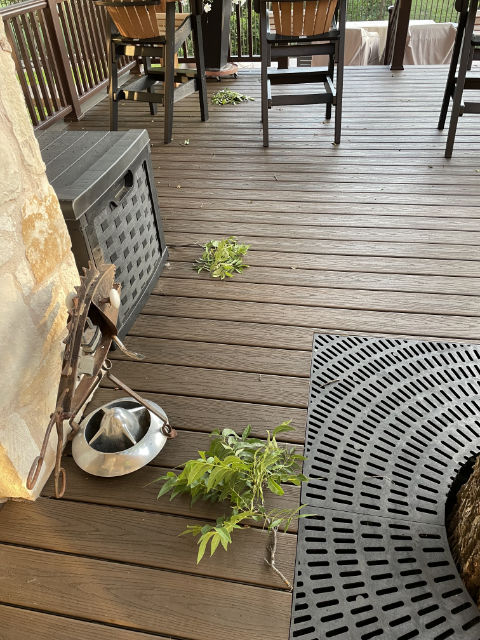
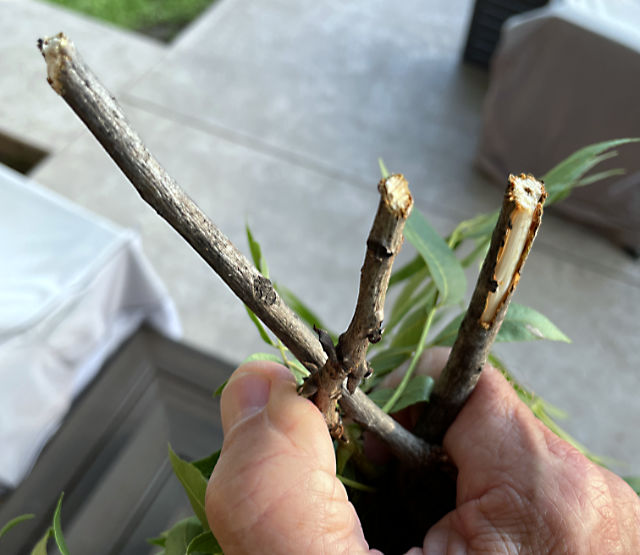
Have you encountered this phenomenon before? I really want to be able to blame the proper party, even if I have no recourse against them.

Let’s switch gears from flora to fauna…the amphibian sort. This Gulf Coast toad (Incilius nebulifer) was making itself at home in our back yard earlier this week.
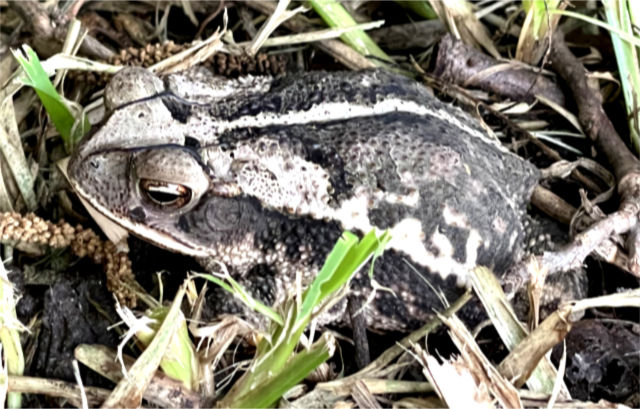
According to this website, this species sports a “white, milky” secretion that can be harmful to toad-licking pets (and humans, too, if you are so bent in that direction). This was actually a concern for us, not because we ourselves are so bent in that direction, but because we were dog-sitting for neighbors. I really wasn’t looking forward to explaining to them that their little pup expired because of an amphibian affinity.

This is the time of year when the white tail bucks are beginning to sprout velvet-covered antlers. We’ve noticed that they tend to hang out in groups, like delinquent teenaged boys, smoking and telling dirty jokes that they really don’t understand. I glanced out our bathroom window last week and counted nine of them browsing in the vacant lot between our house and the golf course.
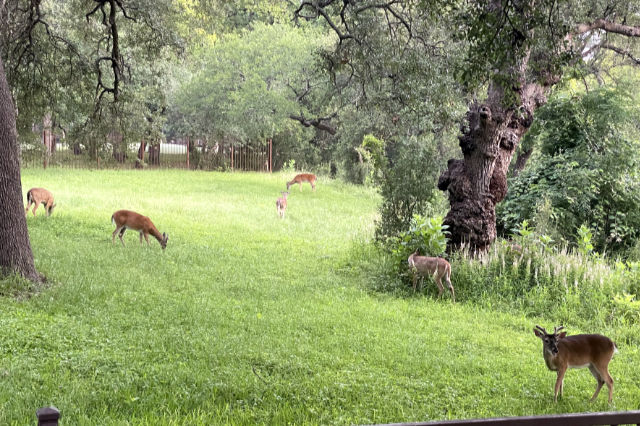
You may be able to pick out six of them in that photo; three others later emerged from the undergrowth near that gnarled live oak on the right. When I went outside to try to get a video, they scattered just like teenaged boys caught smoking and telling…well, you know. Bucks tend to be more antsy than does.

Say, have you ever run across something like this:
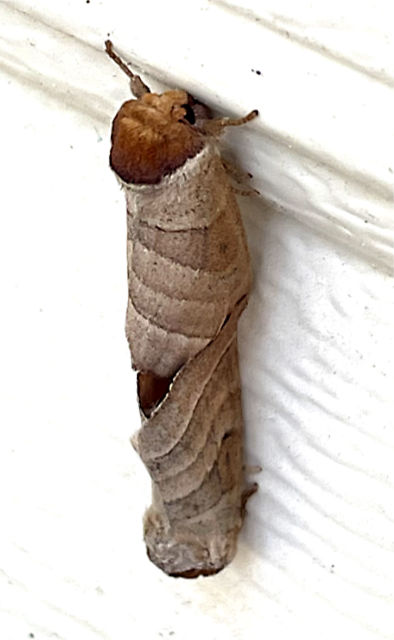
I’ve seen these before but never took the time to research them until now. This is either an Angus’ Datana moth (Datana angusii) or a Walnut caterpillar moth (Datana integerrima), furled up and hanging on our garage door. For the record, I’m betting on the latter, given the proliferation of said caterpillars infesting the pecan trees in our back yard. These moths have a wide range through the entire eastern half of the US, including all of Texas.
This one turned out to be deceased. When I blew on it — my go-to move for investigating insects — it disintegrated. I suspect it succumbed to toad licking; an entire generation of moths is endangered by this risky behavior. [Ed. Please stop with the toad licking references.]

As long as we’re talking moths and sad stories, here’s another one. The aforementioned dog that was temporarily residing with us went on point and called this to my attention:
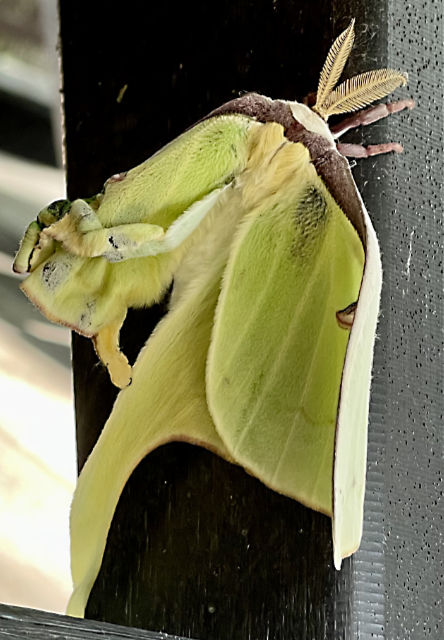
This is a Luna moth (Actias luna), one of the largest moths found in North America, with a wing span up to seven inches. Why is this sad? you might ask. Well, there’s something not right on the left…the left wing has got an obvious issue.
I queried a moth expert who theorized that this is a recently eclosed specimen (that’s a fancy term for an insect that has just emerged from a cocoon). When that occurs, one of the first things to happen is the pumping of hemolymph — a fluid in invertebrates that serves essentially the same purpose as blood — from the insect’s abdomen and into the veins of its wings, thereby “inflating” them. Sometimes, things go wrong, and the preceding photo shows the results. This poor moth will never fly, although the tragedy is somewhat tempered because they have a lifespan of only one week anyway.
This moth was hanging onto the leg of a chaise lounge on our deck, and I would never have noticed it were it not for the dog. Here’s another view:
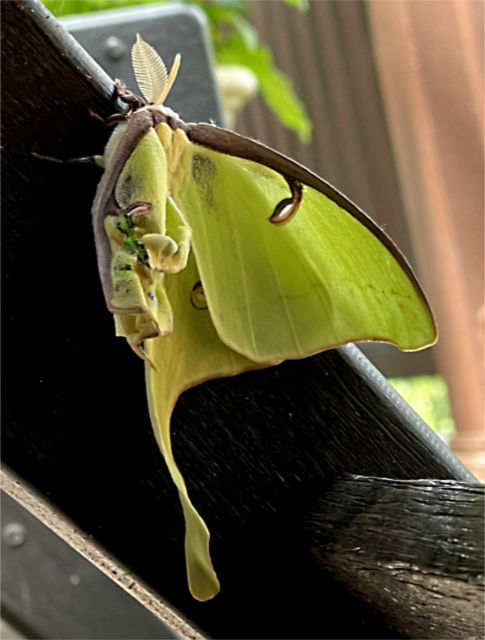

We’re going to stick with the invertebrate family for a few more stories, if that’s OK.
A few days before spotting the Luna moth, I noticed this…something…attached to a vertical section of the deck (lots of stuff happens around our deck — have you noticed that?):
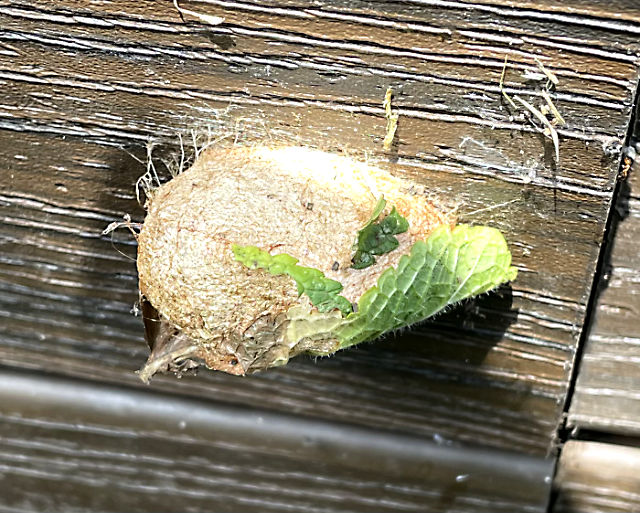
Another insect expert identified this a cocoon for some kind of moth. It was fairly large — about 1.5 inches long. However, she wasn’t sure about the species.
I never thought to associate the cocoon with the Luna moth I photographed in the same vicinity five days later, until earlier today. When I asked the expert if they could be related, she said it was possible. Unfortunately, the cocoon had been knocked off the deck a couple of days ago, so I don’t know if a moth actually emerged from it. Just another unsolved mystery that never made it into a Criminal Minds episode.

Continuing with the moth theme, here’s another beauty:
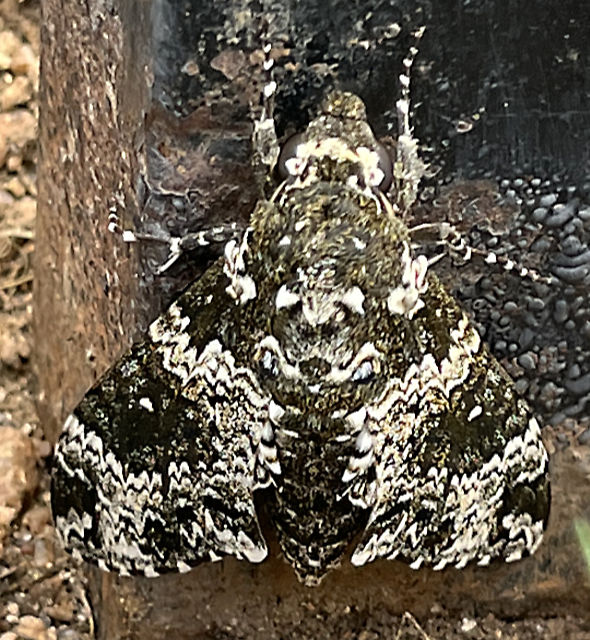
I was visiting with a neighbor just down the street who was working on his fence. He had excavated around a fence post, and called me over to look at what had moved into the hole he’d dug. This is a Rustic sphinx moth (Manduca rustica). It’s another large moth, with a wingspan of up to almost six inches. They are helpful pollinators, and are sometimes mistaken for hummingbird moths, but the two species are completely unrelated.

OK, one more invertebrate story, and this one creeps me out a bit. I’ve made no secret of my mild-to-not-so-mild arachnophobia. I’m working on it, albeit not very diligently, and I’m almost to the point where my first inclination after encountering a spider is to send it across whatever passes for an arachnid Rainbow Bridge. So I’m inordinately proud of the fact that when I saw this scene on the interior of one of our garage doors, I chose to photograph it instead of spraying it.
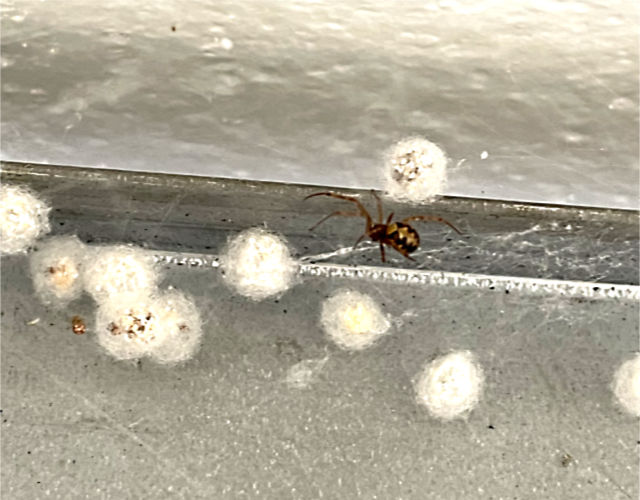
This is a Triangulate cobweb spider (Steatoda triangulosa) and its future family. Here’s a closer, albeit poor quality, look at the spider:
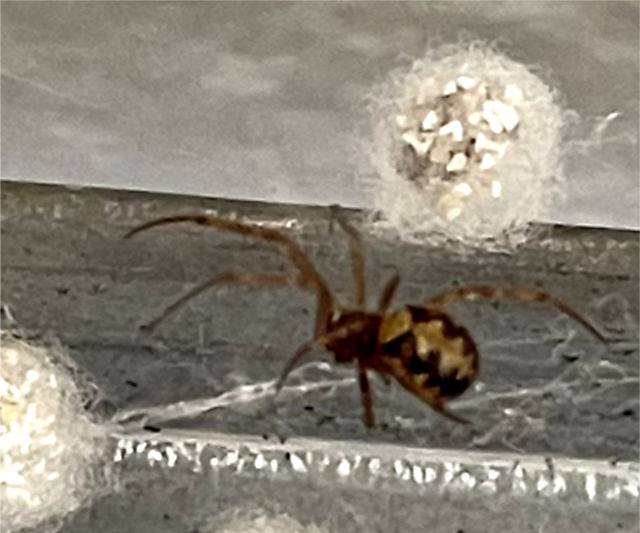
It’s a tiny spidey, only about a quarter inch long, and it appears to be an overachiever when it comes to producing eggs. The main reason I am in a beneficent mood is that this spider will prey on fire ants and brown recluse spiders, neither of which we welcome into our presence. According to the Wikipedia article linked above, each of those egg sacs contain about 30 eggs…which is enough to still induce a “yikes” from me, despite my best attempts to moderate extreme reaction to spiders.

We’ll end this marathon romp through nature with this gentle warning:
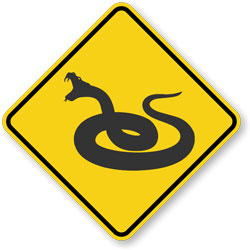
Venomous Snake Photos Ahead
A couple of days ago, we were just about to pull into our driveway as we returned from a morning run around the Resort, and I spotted what resembled a small stick on the pavers. It wasn’t a stick after all; it was this:
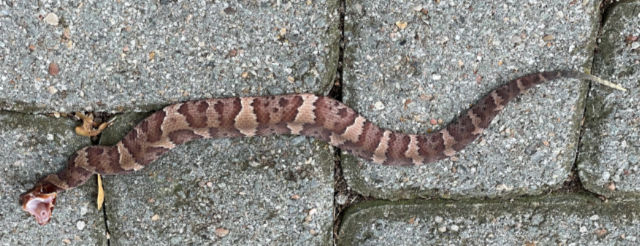
This is a venomous juvenile Northern cottonmouth (Agkistrodon piscivorus) — aka “water moccasin” — a pit viper in the same subfamily (Crotalinae) as Western diamondback rattlesnakes and Eastern copperheads, both of which are also found in our region.
It’s difficult to discern in that photo, but the little (probably only about 12″ long) was engaged in a defensive mechanism called gaping. Here’s a closer look:
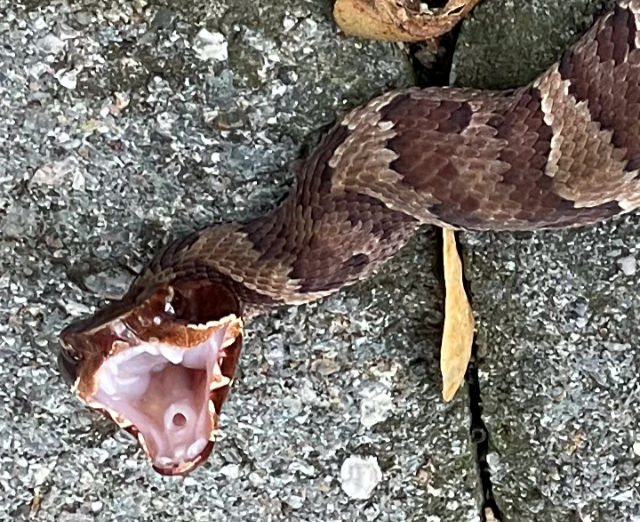
In the closeup, you can see the sheaths that cover the fangs, as well as the entrance to the snake’s trachea, which is set forward so that it can still breathe while feeding on fish or frogs, its preferred meals, as well as young snakes of other species and small turtles.
The juveniles are often mistaken for copperheads because of their coloring, which will turn dark to the point of practically disappearing as the snakes age. The yellow tail is also a sign of youth, one shared with young copperheads, and that, too, will disappear.
Cottonmouths have an undeserved reputation as being aggressive, when in reality they’re simply defensive (and not nearly as “aggressively defensive” as, say, a diamondback rattlesnake). While they will stand their ground when confronted, in my experience it’s quite difficult to convince them to strike, despite the scary gaping expression they employ.
In any event, there’s a pretty significant metabolic price to be paid for the expenditure and reloading of venom by any snake, and so they will do everything in their power to avoid wasting it on subjects much too large to eat, i.e. us. But there’s a line in the sand that, once crossed, will result in an outcome that’s good for neither the striker or the strikee. So, respect is earned and given, at least by me.
Discover more from The Fire Ant Gazette
Subscribe to get the latest posts sent to your email.

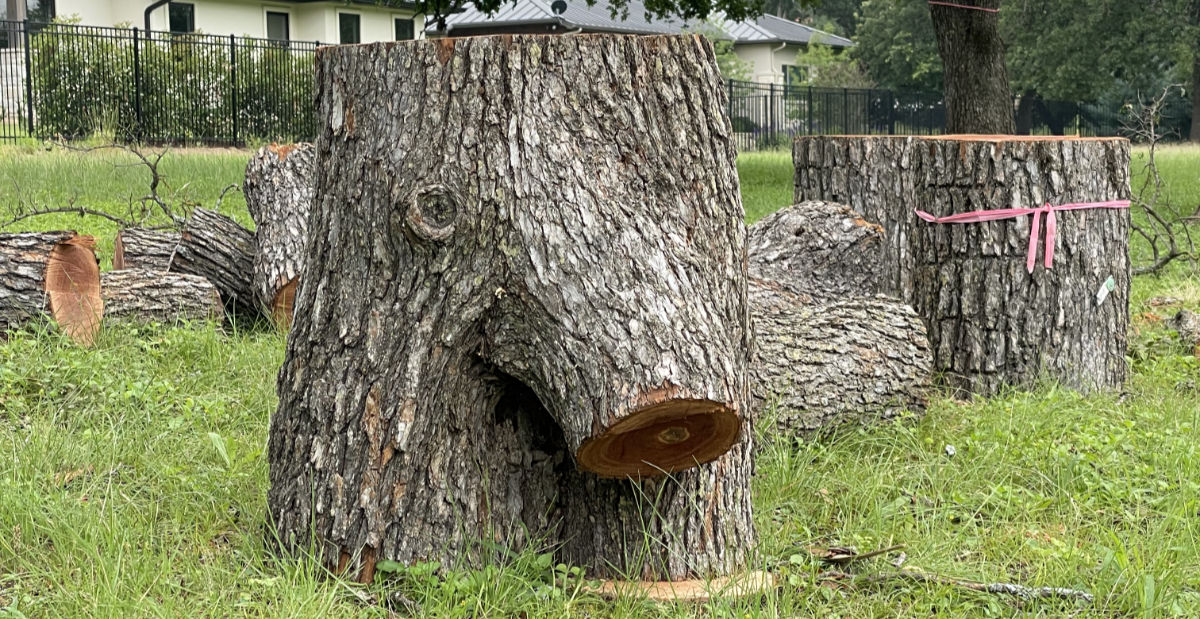
You need a big bug box like my grandson have!!! 🐛 🐞 🐍 🐸
Sherry, thanks for the suggestion. Let me see if Debbie’s OK with a cottonmouth in the house. 😂🤣